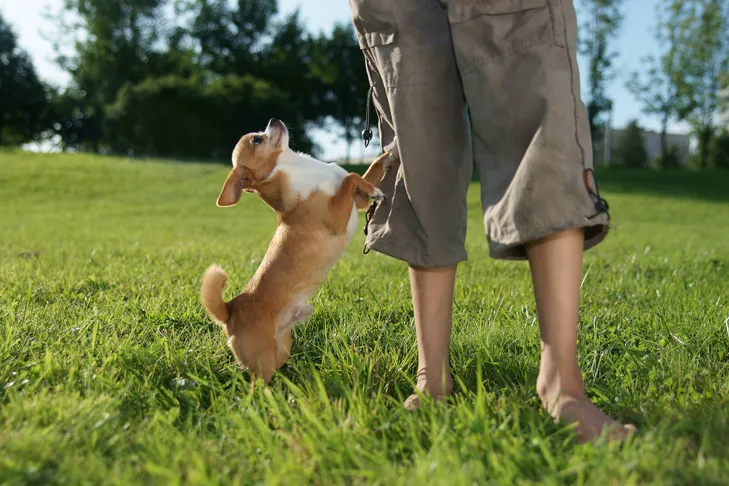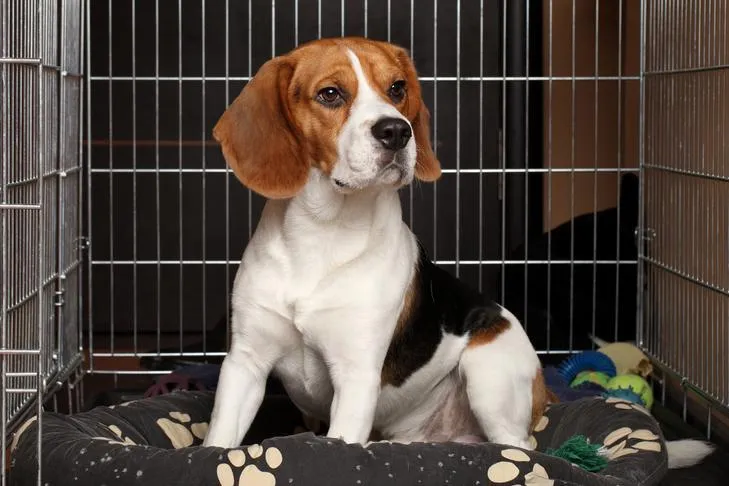Jumping up is a common behavior in dogs, often stemming from a natural desire to greet others face-to-face and a learned response that guarantees attention. While it’s an instinctual canine action, for humans, this exuberant greeting can be bothersome and even hazardous. Muddy paws can soil clothing, and especially for seniors or young children, a jumping dog can cause them to lose their balance. Teaching your dog more polite and safer ways to greet people is crucial for a harmonious relationship. This guide will walk you through effective strategies to curb this behavior and encourage appropriate greetings.
Dogs are motivated to repeat actions that bring them rewards, and for many, your undivided attention is the ultimate prize. This reinforcement isn’t limited to you; other family members, visitors, and even strangers can inadvertently reward jumping. Even negative reactions, such as being yelled at or having their paws grabbed, can be perceived as attention and thus reinforce the behavior. For some dogs, a playful push-away can feel like part of a wrestling game. To effectively eliminate jumping during greetings, you must remove these associated rewards. This involves managing your dog’s environment to prevent them from practicing the unwanted behavior and, more importantly, teaching them an alternative, desirable way to interact.
 Nikolay Titov/Getty Images Plus via Getty Images
Nikolay Titov/Getty Images Plus via Getty Images
Teaching Alternative Greeting Behaviors
Theoretically, ignoring your dog when they jump might eventually lead to the behavior ceasing, as it’s no longer being rewarded. However, the reality is that not everyone you encounter will understand or adhere to this rule. This can lead to frustration for your dog. Therefore, it’s essential to actively teach them what you want them to do instead.
The ideal greeting behavior is up to you. You might prefer your dog to simply keep all four paws on the floor, or you might want them to sit or lie down when greeting someone. The key is to communicate clearly what you want your dog to do, rather than focusing solely on what not to do. For instance, asking your dog to “sit” for greetings is a far simpler and more effective instruction than telling them “don’t jump.”
Training the “Four on the Floor” Greeting
This method teaches your dog to keep all four paws on the ground when greeting people by using treats strategically placed on the floor. The goal is to preemptively reward your dog for keeping their feet down before they have a chance to jump. Follow these steps to teach “four on the floor”:
- Have a helper approach your dog while your dog is on a leash.
- Before the person reaches your dog, scatter several treats on the floor.
- While your dog is engaged with eating from the floor, have your helper calmly pet and greet them.
- Before your dog finishes their treats, have the person step back.
- After several repetitions, repeat the process. This time, extend the greeting duration, continuing to toss treats on the floor throughout the interaction.
- Once your dog consistently keeps all four paws on the ground, allow them to greet the person before you toss the first treat.
- As your dog grasps the concept, gradually reduce the number of treats you offer until the greeting itself becomes the primary reward.
The success of this technique hinges on your speed in dispensing treats. You must anticipate your dog’s inclination to jump and provide the reward before the behavior can occur. If you’re too slow and your dog jumps, have the person turn and walk away while you cease offering treats. Over time, your dog will learn that keeping all four paws on the floor leads to attention and rewards, while jumping results in nothing.
 Bull Terrier puppy sitting in the yard looking up. ©otsphoto – stock.adobe.com
Bull Terrier puppy sitting in the yard looking up. ©otsphoto – stock.adobe.com
Training “Sit” for Greetings
An equally appropriate and desirable greeting behavior is for your dog to sit when greeting people. Similar to the “four on the floor” method, your dog will understand that sitting leads to positive attention, and standing up results in the attention ceasing. Here’s how to train sit for greetings:
- Secure your dog’s leash to a doorknob or a stable piece of furniture.
- From a few feet away, ask your dog to sit. When they comply, approach them calmly. If they stand up, retreat to your starting point and prompt them to sit again. If they remain seated, gently praise and pet them. Continue the greeting as long as they stay in a sit. The moment they stand up, turn away.
- As your dog becomes more proficient at sitting for greetings with you, gradually increase the excitement of your approaches.
- Once your dog reliably sits for greetings with you, begin practicing with friends and family members, following the same steps.
Consistent practice is key to success. Teaching your dog to sit for greetings will be much easier if they already have a solid understanding of the “sit” command in various situations. Reinforcing “sit” before meals, going outside, or other daily routines will make it their go-to polite response. It’s important that your dog can sit without being overwhelmed by distractions. Essentially, you want your dog to offer a sit as their way of politely asking for attention.
 ©FotoJagodka 2012- stock.adobe.com
©FotoJagodka 2012- stock.adobe.com
Preventing Jumping While Training
While you are actively teaching your dog new greeting behaviors, it’s crucial to manage their environment to prevent them from practicing the unwanted jumping. If your dog knows a “go to your place” cue, you can direct them to their mat or crate whenever the doorbell rings. Alternatively, a dog gate at the entrance can prevent your dog from reaching visitors. Keeping your dog on a leash when guests arrive is another effective way to manage their exuberance and prevent jumping.
Keeping toys and treats readily available near the front door can also be a useful management strategy. You can toss a reward away from the doorway to keep your dog occupied as your visitor enters, or your guest can use the toy or treat to positively reinforce your dog for a calm greeting.
Preventing jumping during walks can be particularly challenging because you cannot control every stranger’s interaction with your dog. Until your dog has mastered appropriate greetings with familiar people, it’s best to avoid interactions with strangers. Instead, use a “watch me” cue to redirect your dog’s attention, or a squeaky toy to keep them engaged as the stranger passes by.
When you’re ready for your dog to practice greeting people on the street, inform your companion of the training procedure beforehand. Ask them to ignore your dog if they revert to jumping. With consistent effort and clear communication, your dog will soon learn to greet everyone politely, whether at your doorstep or out in the neighborhood.
To effectively address this common canine challenge and cultivate polite greetings, consider enrolling in professional training. Our expert trainers at Dog Care Story can provide personalized guidance and proven techniques to help your dog master appropriate social skills. For more comprehensive strategies on managing your dog’s behavior and strengthening your bond, explore our resources on how to stop your dog jumping up at guests, how to teach your dog to not jump up, and how to teach my dog not to jump up. If you’re dealing with a younger pup, our guide on how can i stop my puppy jumping up offers age-specific advice. And for foundational obedience, learning how to teach my dog to sit is an excellent starting point.
References
- American Kennel Club. (n.d.). Training Rewards. Retrieved from https://www.akc.org/expert-advice/training/training-rewards/
- American Kennel Club. (n.d.). Attention-Seeking Behaviors in Dogs. Retrieved from https://www.akc.org/expert-advice/training/attention-seeking-behaviors-in-dogs/
- American Kennel Club. (n.d.). Are They Playing or Fighting? Retrieved from https://www.akc.org/expert-advice/training/are-they-playing-or-fighting/
- American Kennel Club. (n.d.). Teach Your Puppy These 5 Basic Commands. Retrieved from https://www.akc.org/expert-advice/training/teach-your-puppy-these-5-basic-commands/
- American Kennel Club. (n.d.). Dog Training Treats. Retrieved from https://www.akc.org/expert-advice/training/dog-training-treats/
- American Kennel Club. (n.d.). Choosing the Right Dog Leash. Retrieved from https://www.akc.org/expert-advice/lifestyle/choosing-right-dog-leash/
- American Kennel Club. (n.d.). How to Teach Your Dog to Sit. Retrieved from https://www.akc.org/expert-advice/training/how-to-teach-your-dog-to-sit/
- American Kennel Club. (n.d.). Training Dogs to Ignore Distractions. Retrieved from https://www.akc.org/expert-advice/training/training-dogs-to-ignore-distractions/
- American Kennel Club. (n.d.). Teaching “Go to Your Place”. Retrieved from https://www.akc.org/expert-advice/training/teaching-go-to-your-place/
- American Kennel Club. (n.d.). Why Crate Training Is Great for Your Dog. Retrieved from https://www.akc.org/expert-advice/training/why-crate-training-is-great-for-your-dog/
- American Kennel Club. (n.d.). Dog Gates. Retrieved from https://www.akc.org/expert-advice/home-living/dog-gates/
- American Kennel Club. (n.d.). Best Dog Toys. Retrieved from https://www.akc.org/expert-advice/lifestyle/best-dog-toys/
- American Kennel Club. (n.d.). Watch Me Command: Grab Dog’s Attention. Retrieved from https://www.akc.org/expert-advice/training/watch-me-command-grab-dogs-attention/
